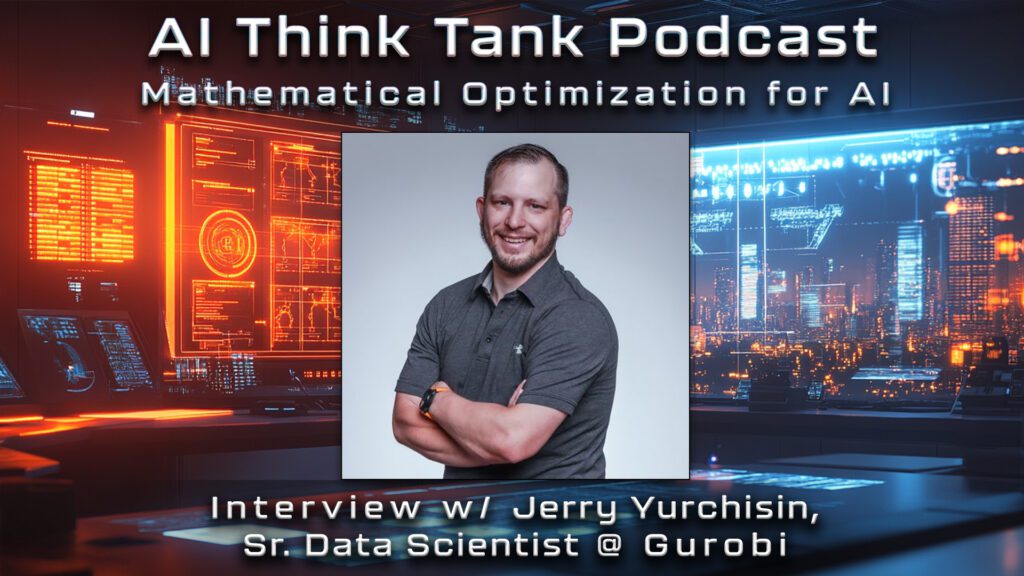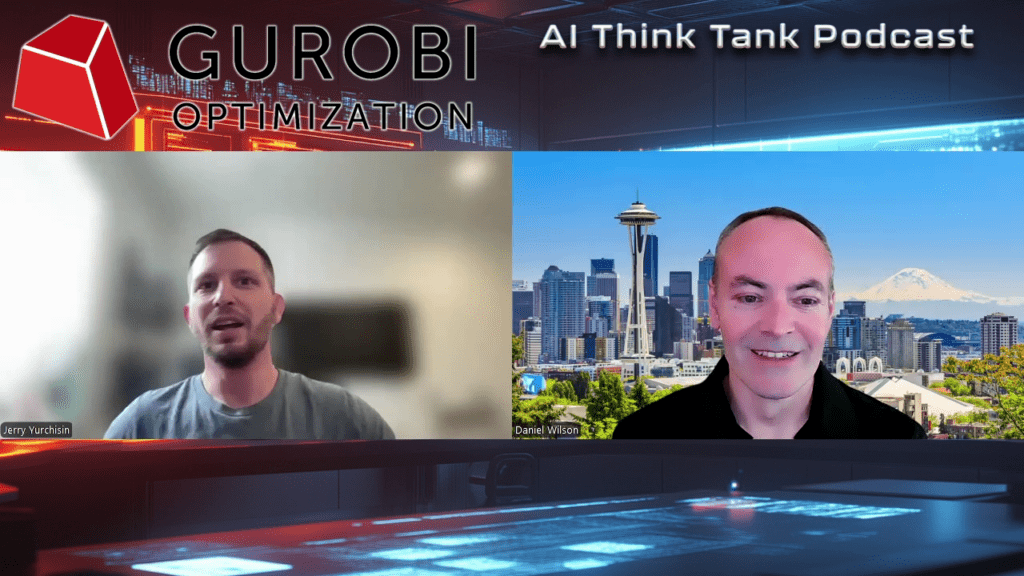Interview / Jerry Yurchisin, Sr. Data Scientist @ Gurobi

As a lifelong systems thinker and technology advocate, I’ve long been fascinated by the intersection of data science, machine learning, and operations research. But nothing quite brings it all together like mathematical optimization. In our latest episode of the AI Think Tank Podcast, I had the pleasure of sitting down with Jerry Yurchisin, Senior Data Scientist at Gurobi, to explore how optimization is being used not just to improve AI, but to fundamentally empower better decision-making across industries.
Jerry brings over a decade of experience in advanced analytics, simulation, and machine learning to his role at Gurobi, the global leader in mathematical optimization. Throughout our conversation, I was struck by both the simplicity and the depth of what Gurobi provides: a fast, precise solver that can tackle some of the world’s most complex problems using the power of math.
“All you really need for mathematical optimization is a problem statement,” Jerry said. “From there, it’s about defining the decisions you can make, your constraints, and your objective, whether that’s minimizing cost, maximizing profit, or improving fairness.”
Let’s break down what makes Gurobi so special and why mathematical optimization is a crucial partner to artificial intelligence in the modern era.
The engine behind optimal decisions
To understand what Gurobi does, Jerry took us back to basics: mathematical optimization is a prescriptive analytics technique. Unlike predictive models that tell you what might happen, optimization tells you what should happen.
“It’s not about throwing more compute at a problem,” Jerry noted. “It’s about applying algorithms smartly to navigate complex decision spaces efficiently.”
The core product is the Gurobi Optimizer, a solver that takes in a mathematical model and delivers the best possible solution, what experts refer to as a globally optimal solution. For companies making billion-dollar decisions, even a 1% improvement can lead to massive returns.
From NFL schedules to power grids
One of the most compelling aspects of Gurobi is its reach. Jerry shared how the NFL uses Gurobi to generate game schedules, a task that used to take months of manual planning and now results in thousands of high-quality options in a fraction of the time.
The optimizer has also played key roles in:
- Supply chain logistics – streamlining complex systems to minimize costs and reduce risk
- Workforce scheduling – ensuring efficient, fair allocation of tasks
- Energy grid management – balancing demand, cost, and sustainability
- Portfolio optimization – improving investment strategies in financial services
“You need to be smart about how decisions are made,” Jerry emphasized. “We help teams get to those optimal decisions faster and more confidently.”
Optimization in AI workflows
With the explosion of interest in large language models and machine learning, one might assume that AI is all about data and compute. But optimization plays a critical role in this space, too. Jerry explained that teams can use Gurobi to:
- Allocate cloud resources more efficiently
- Prioritize training tasks based on cost and performance
- Optimize workflows for AI pipelines
- Plan and schedule inference workloads across distributed systems
At Gurobi, they even use their own optimizer internally to manage testing infrastructure and cloud costs.
“If you’re managing cloud spend or trying to balance when to run models for maximum efficiency, optimization is the tool,” Jerry said. “And we practice what we preach.”
The Burrito Optimization Game: Learning through play
One of the most delightful surprises of the episode was learning about Gurobi’s “Burrito Optimization Game,” a web-based tool designed to teach the fundamentals of optimization in a playful context.
“You decide where to put burrito trucks on a map to serve customers. But there’s a catch, more trucks cost more money,” Jerry explained. “After you make your choice, we run it through our solver and show you the optimal result. You’ll never beat it. The best you can do is tie.”
This game highlights the non-intuitive nature of optimization. What seems right to the human eye often isn’t optimal. That’s the power of letting math do the work.
Real-time and strategic applications
Gurobi isn’t just for one-off decisions. It powers real-time applications like:
- Matching delivery drivers to orders (used by Lyft and Instacart)
- Dynamic routing of vehicles and shipments
- Real-time workforce management
- Day-ahead energy dispatch planning
At the same time, it supports long-term strategic planning, such as quarterly production schedules or supply chain redesigns.
Whether the decision is real-time or part of a broader roadmap, optimization ensures that every choice aligns with your goals and constraints.
“We’re the engine,” Jerry said. “You build the car, the tires, the aerodynamics. But we’re the thing that makes it go fast.”

Making optimization approachable
One of the best parts of this conversation was how accessible Jerry and the Gurobi team are making this technology. Their Python API (gurobipy) is easy to install and use. They offer a free academic license and an online learning license so that developers and data scientists can get started without jumping through hoops.
There’s also a wealth of training content on their YouTube channel, including a full 16-hour training session led by Jerry himself.
“I believe strongly that anyone with a data science mindset can learn optimization,” Jerry said. “The hardest part is representing your problem the right way. But we help with that too.”
Hardware, CUOpt, and the future
Toward the end of our conversation, we dove into the exciting developments around hardware and optimization. While Gurobi’s solver is CPU-based, because many optimization problems don’t parallelize well, there’s growing interest in GPU-friendly methods like NVIDIA’s open-source CUOpt project.
“We’ve partnered with NVIDIA to explore the primal-dual hybrid gradient (PDHG) method,” Jerry said. “It’s still early days, but this could open up new pathways for GPU-powered optimization.”
This is an important shift because it challenges the old belief that optimization doesn’t scale. With the right hardware and algorithms, we’re now seeing previously intractable problems become solvable.
The Gurobi difference
Many companies get their first taste of optimization through open-source solvers or tools like Excel’s built-in solver. But as Jerry pointed out, these tools often hit their limits quickly.
“People hit a wall, assume optimization isn’t viable, and give up,” he said. “But the problem isn’t the technique, it’s the tool.”
Gurobi differentiates itself with speed, reliability, and expert support. Their solver is recognized as the most powerful commercial optimizer available, and customers gain access to a team of experts with over a thousand years of combined experience in mathematical optimization.
Why optimization matters now more than ever
From deep tech to daily logistics, optimization isn’t just a “nice to have.” It’s foundational to modern operations. In a world where efficiency, sustainability, and speed are paramount, being able to make optimal decisions is a competitive advantage.
“We need to reassess our mathematics along the way,” I said during the episode. “Because you never know what you’re missing until you do the due diligence.”
And that’s the crux of it. Optimization helps you discover what you don’t know. It reveals insights that would otherwise remain hidden. It shows you the symphony behind the noise.
Get started with Gurobi
For data scientists, AI engineers, and systems thinkers, I strongly encourage you to explore Gurobi:
- Visit https://www.gurobi.com
- Try out the Burrito Optimization Game
- Check out Jerry’s trainings on the Gurobi YouTube channel
- Install the Python package with pip install gurobipy and begin your journey
Whether you’re managing a power grid, optimizing a football schedule, or building the next AI pipeline, Gurobi can help you do it smarter, faster, and with more confidence.
“You don’t need a quantum computer,” Jerry said. “You just need good math and a good solver.”
And Gurobi is the best solver in the business!
Join us as we continue to explore the cutting-edge of AI and data science with leading experts in the field. Subscribe to the AI Think Tank Podcast on YouTube. Would you like to join the show as a live attendee and interact with guests? Contact Us

